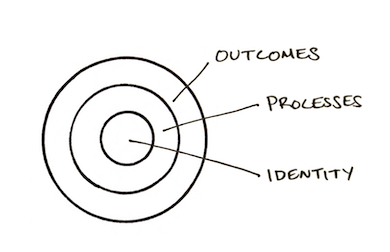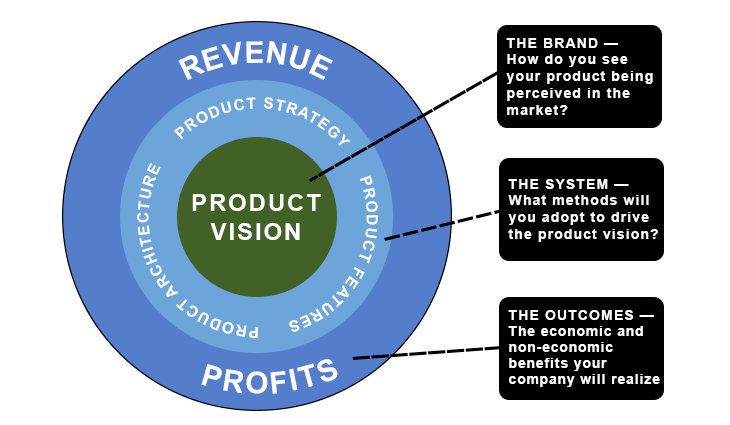Several years back, I came across V2MOM and found it a unique way to think about any entity beyond the vision that extends to the execution. The first problem was to define the vision statement.
My research in this endeavor led to an interesting video that illustrated how NOT to write a product vision (the context was a mission statement, but the idea is the same). If you watch the video, you’ll notice how a well-intended activity can quickly go down the drain.
Another way to explain product vision is from the point of view of a patent claim. It can’t be too narrow because competitors will find ways to work around it, and it can’t be too broad because the patent office will reject it.
Indeed, there is more art than science to creating a product vision. In this guide, we’ll show you how to create a good product vision statement, discuss who is responsible for crafting and executing it, and highlight some examples of product vision statements that drive the development of real-world products.
Table of contents
- What is a product vision statement?
- Who is responsible for defining the product vision?
- What makes a good product vision statement?
- How to craft a product vision statement
- Product vision examples and what makes them tick
- How is a product vision different from a company vision?
What is a product vision statement?
A product vision statement describes the long-term desired outcome for your product. The objective of a vision statement is to drive the value system by allowing everyone to engage consistently to identify ways to achieve a common goal.
A successful product vision should further break down and define the product strategy, roadmap, and features consistent with the vision statement. A vision statement cannot be prescriptive.

Furthermore, a vision statement is not about directly growing the top or bottom line. Atomic Habits, a book by James Clear, explains identity-based habits.
The ID, at the core, is like a vision statement — your brand and what others associate you with, not your revenue and profitability.
A good vision statement should enable calling out leading KPIs (for instance, run five times a week for 30 minutes) rather than trailing KPIs (lose 30 pounds). Yes, losing 30 pounds can be essential, but that is not the primary focus of a vision statement.
Who is responsible for defining the product vision?
I do not believe in having multiple owners for an activity. When everyone is responsible, no one is.
So, who is responsible for the product vision? The short answer is straightforward: the product manager.
Think about it: Who is accountable for converging every discussion across marketing, sales, legal and engineering and, most crucially, has the best understanding of the market they serve?
The product manager must also be able to inspire their team by defining a product vision. Unlike the company vision, the product vision can be a collaborative process. Representation from multiple teams (especially R&D, sales, and marketing) is required to define a product vision quickly with a keen sense of cross-team alignment.
What makes a good product vision statement?
Now that we understand what a product vision is and who is responsible for defining it, let’s zoom in on some qualities that successful product vision statements have in common.
Outside-in
A vision statement must build on a solid sense of market need. In other words, it should demonstrate value creation.
For instance, if a product intends to express its solidarity toward the open source community, it must also show why that is crucial. In other words, the product’s intent is not simply to foster alignment with the open source community, but to demonstrate why the product is vital to the community it serves.
Bounded
To provide context, let’s refer to the pizza store example used in the video mentioned in the introduction.
The mission statement goes from this:
“To serve the tastiest damn pizza in Wake County”
To this:
“The highest-quality entertainment solutions to families.”
How did it go from being a pizza place to offering entertainment solutions? This mission statement is too ambitious.
At the same time, you don’t want a vision statement to become stagnant; the product vision should always be evolving. However, the basis should be a better understanding of the market or a clear opportunity to expand into a different vertical.
In other words, if your product vision aims to solve world hunger, chances are you’re overthinking it.
Inspiring
A well-articulated product vision needs to present a future state and express why that future state is essential to the market the product will serve.
This statement might appear as if value capture is an important theme. As a subtext, it is, because your executives need to explain the product’s value to their stakeholders.
The critical point is that your customers can view this as the light at the end of the tunnel. The team that works towards this vision finds it something worth going above and beyond for.
Relatable
I’ll provide a different analogy here. We discussed the consumption model for a manufacturing solution I was responsible for. To give some context, manufacturers have several lines, and each line has multiple machines.
Two factors are essential for manufacturers. The first is the ability to forecast annual costs. The second is particularly important: understanding the pricing model quickly.
The pricing model should be something that the key stakeholders on the buyer side connect well with. For example, a reference to a line or machine would be effective because stakeholders inherently understand it.
When discussing the pricing model, my colleague said, “Let’s use sessions as a reference point.” The session he was referring to was the number of parallel sessions on the server. If were to ever try that, it would be my last such discussion with the manufacturer!
I would advise my colleague to take that back to the product vision. Treat those who work on realizing this vision as your customers. Ask yourself, can they relate to the statement?
How to craft a product vision statement
When crafting a vision statement, imagine yourself in front of an audience (potential customers) at a conference introducing your product. Start with “We believe” and finish that statement in two to three sentences.
This concept is not unlike the famed press release from Amazon. However, the abridged version should resonate with the audience.
Creating a product vision requires domain knowledge and an inherent understanding of customer pain points and unmet needs.
In some cases, I start with a bulleted list of the pain points and categorize them into larger buckets to identify patterns. In another scenario, it was to capture a user journey and how our product fits into that story in other cases.
I have never written a product vision in a silo. I typically call a few folks from diverse backgrounds (e.g., a product architect, the product manager, the sales lead, etc.) to help craft the vision.
We spend no more than 30 minutes to an hour writing the first version. The product vision statement might go through a few more iterations as I work with my leaders. I do this because it drives consistency in understanding; everyone has skin in the game, and the vision takes an organic communication route.
There is no silver bullet to craft a perfect product vision. The closest thing I can offer is this advice: get your team together, keep it at a 10K level, and capture it in two to three sentences. Also, avoid overthinking it — the product vision statement shouldn’t take more than an hour or two, tops, to create.

Your product vision statement is your brand; your audience should associate with it. The product strategy and roadmap are methods that bring the vision alive. The eventual outcomes are the top and bottom line.
A good vision statement enables a sound product strategy. Strategy elements such as market segmentation, pricing, ecosystem partnerships, and staging (MVP to general availability) should naturally flow from the vision. It should assist with building the right set of features and, more crucially, help with features that are in direct conflict with the vision).
Product vision examples and what makes them tick
Rather than make up a product vision on a consumer product, let’s review two real-world product vision statements (not verbatim, for obvious reasons) and explain why they are successful.
Product vision statement example No. 1
The example below is a product vision statement for a manufacturing solution:
A solution that drives the optimization of every facet of the manufacturing process (from raw material reception to shipping the finished goods), promotes the right organizational behaviors, is intuitive and easy to deploy and integrate, and scales with client needs.
First, I interviewed several members of the team, including the product manager. To my surprise, there was no product vision at all. Everyone I spoke with had a different idea of what this product could or should do.
Then, we discussed what we envisioned and how manufacturers should make the association with our product to improve process efficiency, reduce waste, improve productivity, provide contextual insights, and be intuitive.
Another facet was that every manufacturer had unique needs, and we wanted the product to fit their needs (so they pay for what they use without any unnecessary additions). The vision bounded the application of the product. It was not an ERP system; it was not doing quality checks itself but used them to improve the process. It directly enabled the team to break down the work to a Lego-like product architecture, a pricing strategy that reflected the approach, and a partner strategy that drove seamless integration.
What’s missing in the statement is equally important. The product vision isn’t prescriptive of what the product should do. For example, it doesn’t mention automation, replacing people with machines, or AI-driven opportunities. It stays away from the solution and instead focuses on the pain point.
Product vision statement example No. 2
The following is an example of a product vision statement for a total loss product:
Enable the delivery of a frictionless experience to an insurance consumer, from filing a claim to purchasing a similar vehicle, automating the process, reducing human errors, and enabling everyone in the process chain access to relevant information at the right time.
This example is also specific to an industry and provides overarching goals to deliver a great customer experience. It is indicative of some of the key ideas around automation without delving into specifics.
For instance, automation could imply several things, from e-signatures to paying off outstanding loans. Those should derive from the breakdown of the vision into a strategy and the definition of the product roadmap.
How is a product vision different from a company vision?
Conceptually, a company vision and product vision are similar. They are a guiding light but do not tell you how to drive your car to the end goal.
However, company vision statements are typically decided at the C-suite level, especially the larger ones. The employees at the lower rung follow along.
Product vision cannot conflict with the company vision. However, it is a more democratic process. It is possible to engage the key stakeholders to collaborate (and hence buy in).
The post What is a product vision statement? Overview with examples appeared first on LogRocket Blog.
from LogRocket Blog https://ift.tt/Rrx3cGQ
via Read more



